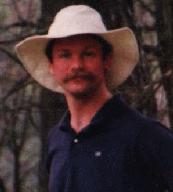Marshall Chapman
 Marshall Chapman is a recent PhD graduate from the University of
Massachusetts, where he worked under the direction of Mike Rhodes. Having
graduated with a B.A. in Religion, he apparently had a conversion to the
geological sciences similar to that of Saul on the road to Damascus. After
filling the gaps in his science background (very few courses in religion were
accepted for entrance into graduate geological studies), he began working
with Rhodes in the Ronald B. Gilmore X-ray Analytical Facility in 1988, where
he put together a "rocks-to-numbers" guide to sample preparation and analysis
(humorously called "The Marshall Plan").
Marshall Chapman is a recent PhD graduate from the University of
Massachusetts, where he worked under the direction of Mike Rhodes. Having
graduated with a B.A. in Religion, he apparently had a conversion to the
geological sciences similar to that of Saul on the road to Damascus. After
filling the gaps in his science background (very few courses in religion were
accepted for entrance into graduate geological studies), he began working
with Rhodes in the Ronald B. Gilmore X-ray Analytical Facility in 1988, where
he put together a "rocks-to-numbers" guide to sample preparation and analysis
(humorously called "The Marshall Plan").
For his PhD dissertation, Chapman began working on the Mafic and Silicic
Layered Intrusion of The Isle au Haut Igneous Complex, Maine. The original
purpose of the study was to document the petrogenesis of a granitic chamber
which had been invaded by a basaltic magma This basaltic magma had
apparently ponded on the crystalline floor of the chamber; and, the intent of
the study was to disprove mixing between granitic and basaltic magmas. The
project has proven otherwise.
The Isle au Haut Complex reveals a complex interaction between the basalt and
granite, involving differences in thermal and chemical diffusion. This
intense interaction produced a hybrid liquid from the two end-members and
crystallized to form a thin layer of dioritic rocks between the granite and
(now) gabbro. The work is an exciting development in our understanding of
magma chamber processes and integrates aspects of petrology, structural
geology, geochemistry, fluid mechanics, and isotopic geology. The most
crucial aspect of this study, however, has involved careful field work: most
of the fundamental conclusions devolve from the constraints placed by field
observations on the geochemical and petrological data. For instance, many of
my analyses can be geochemically modeled by means of fractional
crystallization. The field relations, however, prohibit this process as a
viable means due to the position of these rocks within the magma chamber.
Other explanations, therefore, must be explored. As I have told many of my
colleagues, I can model anything, but it must make geologic sense.
The research has matured, and most of the major ideas have been sorted out as
to the structure and workings of a silicic magma chamber periodically invaded
by basaltic magma. Many questions, however, remain unanswered and warrant
further exploration. These include:
1) isotopic evolution of the Isle au Haut Complex and what isotope study may
reveal about chemical interaction,
2) the petrogenesis of the volcanic units on Isle au Haut (which are also
bimodal) and their relationship to the underlying plutonic units,
3) the evolution of the upper granitic unit with respect to the volcanics,
and
4) further exploration of my models and their application to other plutons in
the Coastal Maine Magmatic Complex (e.g., Vinalhaven).
5) Finally, other mafic and silicic layered plutons need reexamination in the
light of this current research (e.g., the igneous complexes of the Channel
Islands, UK).
The research has not been fully accepted throughout the petrology community
and criticisms have been voiced that this relationship is "but of limited,
local interest." Field trips by Chapman to other complexes (throughout Maine
and the Channel Islands of Guernsey and Jersey, UK) and documentations around
the world (French Massif Central, Chile, Spain, Ireland and Scotland)
indicate that the phenomena may not be so rare, and in fact far more common
than we suspect. Chapman is expanding the research on Isle au Haut to a
bimodal volcanic cap to the plutonic complex. The intent of this research is
to explore whether the rhyolite flows and silicic pyroclastic deposits (which
have fine-grained basaltic xenoliths) are the volcanic equivalents to the
underlying chamber.
Chapman taught Marine Geology and Petrology at Hamilton College in 1995.
Currently, he holds a temporary position as Visiting Lecturer in The
Department of Geology at Appalachian State University in Boone, NC 28608
(704) 262-3049. While not studying plutons and volcanic deposits (and
generally making a nuisance out of himself), Chapman can be found
sea-kayaking, cross-country skiing, playing golf, or playing his banjo and
guitar.
 Correspondence to: Marshall Chapman
Correspondence to: Marshall Chapman


 Marshall Chapman is a recent PhD graduate from the University of
Massachusetts, where he worked under the direction of Mike Rhodes. Having
graduated with a B.A. in Religion, he apparently had a conversion to the
geological sciences similar to that of Saul on the road to Damascus. After
filling the gaps in his science background (very few courses in religion were
accepted for entrance into graduate geological studies), he began working
with Rhodes in the Ronald B. Gilmore X-ray Analytical Facility in 1988, where
he put together a "rocks-to-numbers" guide to sample preparation and analysis
(humorously called "The Marshall Plan").
Marshall Chapman is a recent PhD graduate from the University of
Massachusetts, where he worked under the direction of Mike Rhodes. Having
graduated with a B.A. in Religion, he apparently had a conversion to the
geological sciences similar to that of Saul on the road to Damascus. After
filling the gaps in his science background (very few courses in religion were
accepted for entrance into graduate geological studies), he began working
with Rhodes in the Ronald B. Gilmore X-ray Analytical Facility in 1988, where
he put together a "rocks-to-numbers" guide to sample preparation and analysis
(humorously called "The Marshall Plan").
